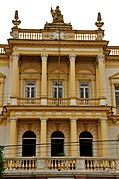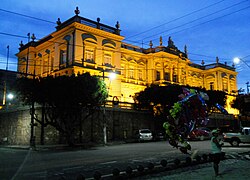
Palacio de La Moneda, or simply La Moneda, is the seat of the President of the Republic of Chile. It also houses the offices of three cabinet ministers: Interior, General Secretariat of the Presidency, and General Secretariat of the Government. Located in downtown Santiago, it occupies an entire block in the Civic District, bordered by Moneda street to the north, Morandé street to the east, Alameda del Libertador Bernardo O'Higgins to the south, and Teatinos street to the west.
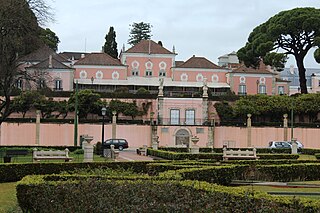
The Belém Palace, formally the National Palace of Belém,, is the current official residence of the president of the Portuguese Republic, the head of state of Portugal. Located in the Belém District of Lisbon, the palace's main façade fronts the Praça Afonso de Albuquerque, facing the Tagus River. A former residence of the Portuguese royal family, the Belém Palace complex is made up of various buildings, wings, courtyards, and gardens, built variously from the 18th to 21st centuries.
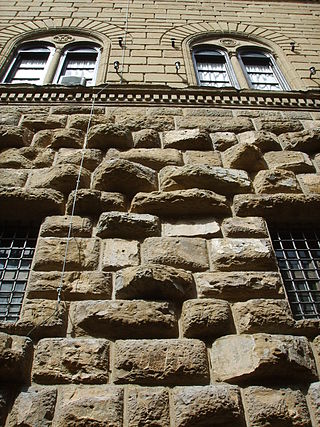
Rustication is a range of masonry techniques used in classical architecture giving visible surfaces a finish texture that contrasts with smooth, squared-block masonry called ashlar. The visible face of each individual block is cut back around the edges to make its size and placing very clear. In addition the central part of the face of each block may be given a deliberately rough or patterned surface.

The Palace of Ajuda is a neoclassical monument in the civil parish of Ajuda in the city of Lisbon, central Portugal. Built on the site of a temporary wooden building constructed to house the royal family after the 1755 earthquake and tsunami, it was originally begun by architect Manuel Caetano de Sousa, who planned a late Baroque-Rococo building. Later, it was entrusted to José da Costa e Silva and Francisco Xavier Fabri, who planned a magnificent building in the modern neoclassical style.

The Palácio do Planalto in Brasília is the official workplace of the president of Brazil. The building was designed by Oscar Niemeyer in 1958 and inaugurated on 21 April 1960. It has been the workplace of every Brazilian president since Juscelino Kubitschek. It is located at the Praça dos Três Poderes, to the east of the National Congress of Brazil and across from the Supreme Federal Court.
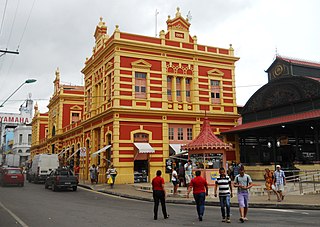
The Mercado Adolpho Lisboa, also called Mercado Municipal or Mercadão , is a marketplace located in Manaus, Brazil. It lies on the shore of the Rio Negro. The market was constructed between 1880 and 1883. The building was based on the Les Halles marketplace of Paris, France. The building's metallic structures were built in Paris and sent to Manaus by ship. Has two completely different facades, one facing the Rio Negro and one facing the public road. Is an important historical and architectural building of the city, the Municipal Market also stands out today as a cultural and tourist center. The market is one of the largest open markets in the city of Manaus, offering fresh fruits, spices, fish, souvenirs, traditional indigenous medications and among other products. The building was interdicted in 2006 for restoration works and was delivered after seven years on October 23, 2013.

The National Palace is the seat of the federal executive in Mexico. Since 2018 it has also served as the official residence for the President of Mexico. It is located on Mexico City's main square, the Plaza de la Constitución. This site has been a palace for the ruling class of Mexico since the Aztec Empire, and much of the current palace's building materials are from the original one that belonged to the 16th-century leader Moctezuma II.

The Palace of Mafra, also known as the Palace-Convent of Mafra and the Royal Building of Mafra, is a monumental Baroque and Neoclassical palace-monastery located in Mafra, Portugal, some 28 kilometres from Lisbon. Construction began in 1717 under King John V of Portugal and was completely concluded in 1755.

Portuguese architecture refers to both the architecture of Portugal's modern-day territory in Continental Portugal, the Azores and Madeira, as well as the architectural heritage/patrimony of Portuguese architects and styles throughout the world, particularly in countries formerly part of the Portuguese Empire.
The Quinta de Santo António is a well-preserved Pombaline quinta in the freguesia of Carcavelos e Parede, in the municipality of Cascais, on the Portuguese Riviera. It is the seat of St. Julian's School.

The Caramuru Building is an office building in Salvador, Bahia, Brazil. It was designed by the architect Paulo Antunes Ribeiro (1905–1973) for Prudência Capitalização, an insurance company. Construction began on the structure in 1946 and it opened in 1951. The Caramuru Building was one of the first Modernist buildings constructed in the Northeast Region of Brazil, closely following the construction of Hotel de Bahia. It was widely recognized by the domestic and international architectural press; it was described as having a "graceful, almost abstract elegance [...] contrasted with the robust architecture of Bahia." The structure fell into disrepair but remains in the Comércio district. It is a protected structure by the state of Bahia and has provisional protected status by the by National Institute of Historic and Artistic Heritage (IPHAN).

Casa Nobre de Jequitaia, also known as Casa à Avenida Frederico Pontes, is an unused residence in Salvador, Bahia, Brazil. It is located in the Calçada neighborhood and likely dates to the 18th century. It was once connected by a corridor to the Casa Pia and College of the Orphans of Saint Joachim, an architectural complex that consists of a chapel, school, and orphanage. Casa Nobre de Jequitaia has two stories and is typical of Portuguese colonial architecture in Brazil: it consists of two stories and a small attic. The ground floor served as an entrance and housing for slaves and servants, the upper floor for the owner and his family; the small attic was used for bedrooms. It was listed as a historic structure by the National Institute of Historic and Artistic Heritage in 1938.

The Palacio de Aldama is a neoclassical mansion located diagonally opposite to the old Plaza del Vapor, and in front of the old Campo de Marte; present day Parque de la Fraternidad, in Havana, Cuba. Built in 1840 by the Dominican architect and engineer Manuel José Carrera, its main facade of columns spans one block on Calle Amistad between Calles Reina and Estrella.

The Palace of the Deputation of Pontevedra, in Pontevedra, Spain, is the seat of the Provincial Deputation of Pontevedra, the provincial government of the province of Pontevedra. It is located between the Alameda de Pontevedra and the Palm Trees Park.
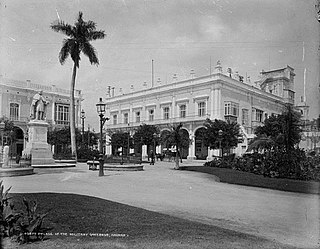
The Palacio del Segundo Cabo was built in the last decades of the 18th century, between 1770 and 1791, as part of the urban improvement project around the Plaza de Armas.

The Ciudad de la Justicia de Pontevedra or the Pontevedra Judicial Complex is an architectural and judicial complex of the city of Pontevedra (Spain), consisting of two large court buildings built in 1998 and 2019 in the A Parda district.
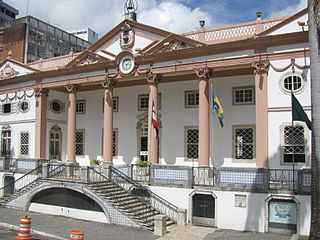
The Palace of the Commercial Association of Bahia is a building that houses the headquarters of the Commercial Association of Bahia (ACB), which had its inauguration on January 28, 1817. It is located in the Comércio neighborhood in the municipality of Salvador, capital of the state of Bahia in Brazil.
The Palace of Justice is the seat of the Court of Justice of the state of São Paulo. It is located in the old center of the city of São Paulo, between the squares Praça da Sé, Praça João Mendes Jr., and Praça Clóvis Bevilácqua, near the São Paulo Cathedral, the Anchieta Palace and the Matarazzo Building. Nearby one finds the headquarters of the Order of Attorneys of Brazil and the Public Prosecution Office of the State of São Paulo, as well as the Law School of the University of São Paulo. Its construction happened due to the expansion of the São Paulo judicial sphere and demographic growth, which meant the Court of Justice needed to be housed in a new headquarter, and no longer in old mansions in the central region of São Paulo.

The Benjamin Constant Bridge, also known as Metallic Bridge, is a suspension structure located on Sete de Setembro Avenue that crosses the Igarapé do Mestre Chico between the Cachoeirinha and Centro neighborhoods, in the Brazilian city of Manaus, capital of the state of Amazonas.
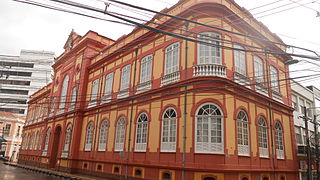
The Amazonas Public Library is located in the center of the city of Manaus, the capital of Amazonas. Founded in 1871, it is the oldest public library in the state and the largest in terms of collections.




